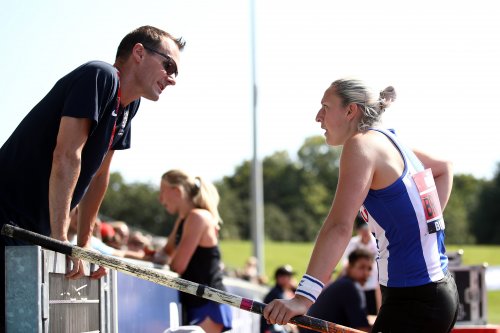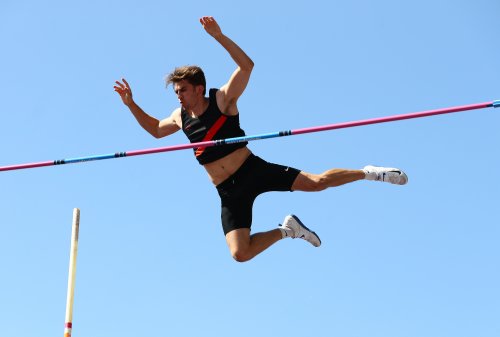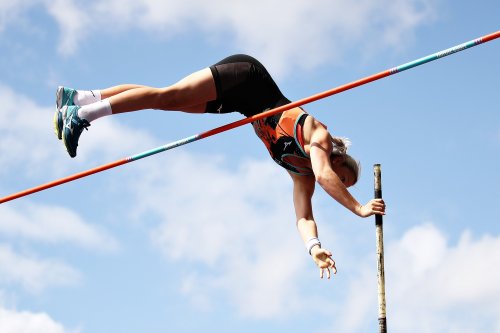This is part 2 of Stuart Weir’s series on pole vault coach, Scott Simpson, one of our most popular coaches on @runblogrun.
This is piece is about an approach to coaching, as Stuart explains, in Scott’s own words. It is a good piece for coaches to appreciate.
 Scott Simpson speaks with Holly Bradshaw, photo by Stuart Weir
Scott Simpson speaks with Holly Bradshaw, photo by Stuart Weir
 Harry Coppell, photo by Getty Images / British Athletics
Harry Coppell, photo by Getty Images / British Athletics
Scott Simpson Part 2 An approach to coaching
In the first article Scott Simpson, GB National Performance Institute Senior Coach for pole-vault, described how he had started coaching while still competing. In part two we discuss his approach to coaching.
Simpson’s approach to coaching is built on strong personal relationships but also reflects the intrinsic differences between track and field: “Field event coaches travel more with athletes. Pole-vault lends itself to this – the challenges of travelling with poles are such that it is hugely advantageous for an athlete to have their coach with them, probably more so than any other event. Because of the amount of time you spend together on the road, it’s useful if you have a good personal relationship”.
“Ten years ago I was heavily criticized for the amount that I was involved supporting athletes during the competition. But it is so different from track because once the race starts a coach cannot do anything or offer any advice. While ultimately the athlete still makes the decision in field events, they can share that dialogue with a coach between jumps – to gather more information which they can use to make the decision. It can also be helpful for the athlete to share their thought process was someone else as a sounding board. That can shape their decision about what to do differently or what to change for the next attempt. That is why it is so advantageous for the coach to be there at the competition.
“Pole-vault is dangerous, so having that information is really important. In answer to the criticism, I would say that you don’t see a soccer or American football team going to play without their coach being there. The coach pulls the team together during different phases of play and debriefs etc. It is the same in a motor rally where the co-driver is feeding in important pieces of information – or the caddie in golf. That is the role of the pole-vault coach. It is quite different from the role of the sprints coach and I think it has historically been misunderstood”.
Some coaches just help their athletes technically, others seem to be coach and manager. How does it work with Scott and his athletes, I wondered: “You don’t really want to be traveling with someone if you don’t get along. So I work hard to foster the good relationships which brings with it closeness, which I feel I have with the athletes I work with. But I do not intrude into managing their personal lives. If they ask my opinion, I’ll give it or if I think they’re doing something in their personal life which is detrimental to their athletic endeavors, I will find an appropriate way to share that opinion with them. But ultimately it is their life and their career and they have to make those decisions for themselves, I’m just there to guide them. They have to make the calls and they will live by them. I will guide and steer but I’m not a dictator”.
Scott has explained why he feels it is helpful for a coach to travel with the athletes they coach. I asked him to unpack the benefits: “I think a lot of athletes just take strength from their coach being there. It’s a source of support and a source of togetherness to feel that your coach, who is on the journey with you, is literally there beside you. There’s a value in a championship in being able to debrief in person between rounds which is a parallel perhaps to talking to your coach between jumps. To be able to sit down with your coach after the heats and discuss what happened – because I think that doing that on zoom or over the telephone is not as powerful as doing it in person. Don’t get me wrong, I think there is a slight advantage in in having your coach there for the track athlete but I don’t think it’s as significant as in field events and especially the pole-vault”.
I was also keen to know about how the relationship works between coach and athlete in the middle of a competition. Take for example the recent European Indoor Championships in Torun, when Holly had had two failures at a height she was well capable of clearing. She could go for a third attempt or pass and go higher. But who makes the decision?
“Generally the two of us, but a lot of the competition tactics are led by me. Holly is out there focusing on what’s happening with her vaulting and is therefore not always fully aware of what is going on with the rest of the competition but I am watching the scorecard and I know exactly where things are. The first priority is to win a medal of some sort and when a medal is secure, priority two is to go for the win. And in Torun the reason she took the third attempt at 4.70 was because the medal wasn’t in the bag. But if you remember in the Doha World Championships, when she was ready to take her third attempt of 4.85 there were already three girls who had cleared that height so therefore it was worth passing that and going higher. So every situation is different in terms of what the right decision is and what the pros and cons are. So we’re looking at the scorecard and seeing what the situation of the competition is. Based on that, I won’t dictate it, I will make a suggestion to Holly. The aim is to go for the win and most of our decisions center around that philosophy”.
 Holly Bradshaw, photo by Getty Images / British Athletics
Holly Bradshaw, photo by Getty Images / British Athletics
I was also wondering how much of the conversations during a competition are technical: “The event is highly technical but athletes shouldn’t be thinking about several technical things as they vault. There are so many technical aspects to it and there’s absolutely a time and place for working on aspects like that. But if someone is on the runway thinking ‘I got to get my run up right, I’ve got to be tall at takeoff, then I got to be inside my hands at takeoff and do this with my legs’, that is a recipe for disaster that is never going to work. Doing some mental rehearsal at home while listening to an audio tape, you can go through all of those things. Or watching a video with your coach and going through the jump from start to finish and unpicking it, may be. But when you’re taking a jump, the most you can think of is two things – normally one of those would be towards the start of the run-up and the other one was the end of the jump. That might be achievable but more than two would be a disaster. Even two, close together is probably not going to work”.
In part three Scott reflects on the fraternity of pole-vault.
Author

Since 2015, Stuart Weir has written for RunBlogRun. He attends about 20 events a year including all most global championships and Diamond Leagues. He enjoys finding the quirky and obscure story.
View all posts




















